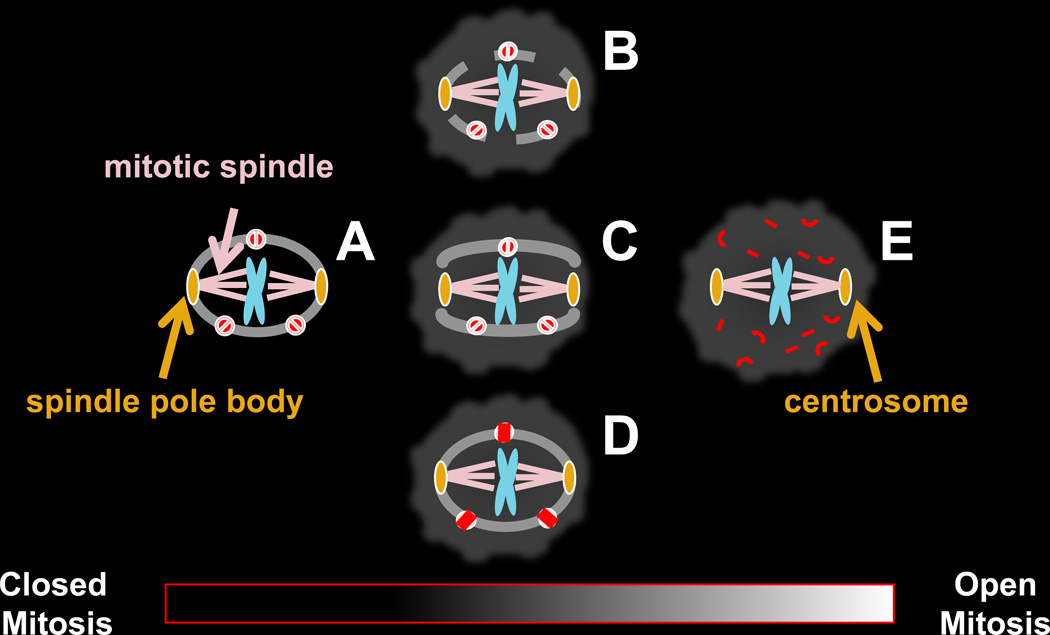Figure 2. The nucleus in mitosis.
The nucleus changes dramatically from its interphase state (Figure 1) as cells enter mitosis. The chromatin previously tethered to the nuclear periphery is released, the chromosomes condense into their mitotic metaphase configuration, and the microtubule cytoskeleton is typically (but not always [44, 48]) reorganized by the microtubule organizing center, called the centrosome or spindle pole body (SPB), into the mitotic spindle that attaches to and then segregates the duplicated chromosomes to opposite sides of the cell.
The two best-characterized examples of mitosis-specific nuclear changes are the closed mitosis of the fission yeast Schizosaccharomyces pombe and the budding yeast Saccharomyces cerevisiae in which the NE remains intact (2-A) and the open mitosis of mammalian cells (2-E) in which it breaks down. There are also examples of mitosis that for a variety of reasons cannot be characterized as strictly open or strictly closed (2-B, 2-C, 2-D).
A. In the closed mitosis of some yeast cells, the duplicated SPBs are embedded in the nuclear membrane at mitosis and nucleate mitotic spindle formation within the confines of the nucleus. By definition, the presence of the SPB in the NE is essential for this type of closed mitosis. In some organisms the SPB is embedded in the NE during interphase and mitosis (e.g. S. cerevisiae) whereas in others it lies in the cytoplasm in close proximity to the NE in interphase, and enters the NE at mitosis (e.g. S. pombe)[30]. As the spindle elongates and applies pressure to opposite sides of the nucleus the spherical nucleus divides into two smaller spheres. These properties of closed mitosis are best characterized in S. cerevisiae and S. pombe but are not necessarily typical of other yeast or fungi or other organisms that undergo closed mitosis, some of which do not form a spindle inside of the nucleus [7].
B, C, D. Some types of mitosis are neither open nor closed. There are instances of cells that assemble an intranuclear mitotic spindle from NE embedded SPBs, but later in mitosis holes form in the NE, as in the fission yeast Schizosaccharomyces japonicas [24, 25]. In some cell types, such as multinucleated Drosophila melanogaster embryos [23] (B), nuclei undergo only partial NEBD. In other cell types, such as Chitridiales [7, 26], polar openings form in the NE, through which the cytoplasmic spindle extends (C). Cells with an ultrastructurally intact NE can also have a disrupted permeability barrier, resulting in the mixing of nucleoplasm and cytoplasm due to changes in NPC composition and/or permeability (D) as in the mitotic cycle of the filamentous fungus, Aspergillus nidulans [29], and during meiosis in the fission yeast S. pombe [27, 28].
E. In the open mitosis of mammalian cells, brought about by NEBD, the nuclear lamins (that line the inner NE in interphase) depolymerize, the NPCs disassemble and the NE is reorganized into the mitotic ER [21, 37] to which some of the membrane associated components of the nuclear lamina and NPC also relocalize. Although there are exceptions (e.g. Planarians lack centrosomes [48]) in animal cells the mitotic spindle is typically organized by centrosomes and can gain access to the chromosomes only after NEBD. Unlike the functional equivalent of the centrosomes in yeast (the spindle pole body) the centrosome is not embedded in the NE, even in interphase, although it lies in the cytoplasm in close proximity and tethered to the NE [44, 49]. Following mitosis, membrane associated components of the lamina re-associate with the condensed mitotic chromosomes to nucleate reassembly of the NE [50].

